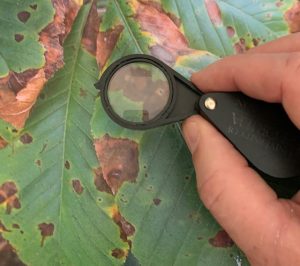
Diagnosing landscape problems can be tricky. There are basic steps that can be useful in solving plant problems in your landscape.
Step 1 Identify the Plant. By knowing the type of plant affected, you can begin relating causes to symptoms you see on the plants.
Step 2 Survey the site. Is the problem occurring to one plant or a group of plants? Is it a local problem in your landscape only or are the other plants of the same type throughout the neighborhood showing the same problem? What has been the recent weather pattern? Is the soil well drained or wet and boggy? Is there an open drain spout near the plant?
Step 3 Ask questions. Has there been anything unusual spilled or applied within the vicinity? Was fertilizer recently applied, how much, what kind? Has the plant been sprayed with pesticide?
Step 4 Examine the plant thoroughly. Look closely at the foliage. A magnifying glass is useful for detecting pests like spider mites and lacewing bugs. Flower thrips and mites can be detected by shaking a flower over a piece of white paper. Are leaves showing a tip burn or scorching (usually caused by environmental stress)? Are there distinct spots on the foliage (indicating a possible disease)? Do roots appear dark and decayed (possible fungus or too wet soil), or stubby (possible nematode problem) or white and healthy?
After careful inspection of the plant and site, if you’re still stumped, collect and bring samples to our next Plant Clinic.
 The March plant clinic will be held Friday, March 25 from 9 a.m. to noon in Fort Walton Beach at the Okaloosa Farmers’ Market located at 1954 Lewis Turner Boulevard close to the Northwest Florida Fairgrounds. It will be in the open covered pavilion.
The March plant clinic will be held Friday, March 25 from 9 a.m. to noon in Fort Walton Beach at the Okaloosa Farmers’ Market located at 1954 Lewis Turner Boulevard close to the Northwest Florida Fairgrounds. It will be in the open covered pavilion.
The plant clinic is designed to provide a place and time for people to bring in samples of plants for diagnosis including weeds for identification.
If you have a plant problem that you would like diagnosed, bring a sample of the weed, plant, insect, etc., to the clinic. Be sure to bring a fresh sample that represents what is seen in the landscape. This may include a plant stem with several leaves, a 4-inch square of grass with roots attached, etc.
You may also bring a sample of your soil for pH testing.
 1
1
